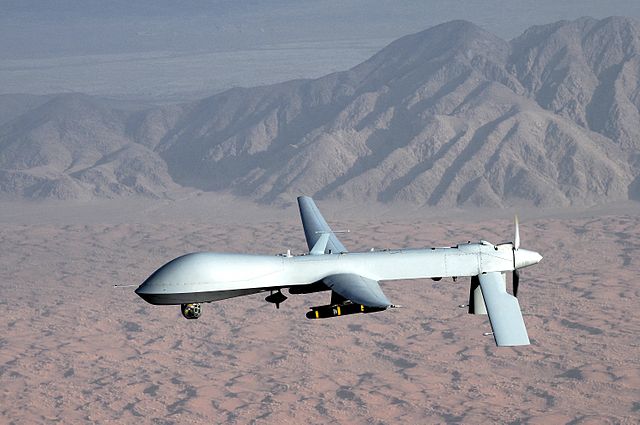Updating the 2001 AUMF at Long Last? On the Flake-Kaine Bill
It is past time for Congress to update the 2001 Authorization for the Use of Military Force (AUMF), explicitly authorizing the armed conflict with the Islamic State while also adding further important reforms to that foundational instrument. The bill that Senators Flake (R-AZ) and Kaine (D-VA) introduced this week would serve that purpose well.

Published by The Lawfare Institute
in Cooperation With

It is past time for Congress to update the 2001 Authorization for the Use of Military Force (AUMF), explicitly authorizing the armed conflict with the Islamic State while also adding further important reforms to that foundational instrument. The bill that Senators Flake (R-AZ) and Kaine (D-VA) introduced this week would serve that purpose well.
AUMF reform has been debated for years. In 2010, our colleague John Bellinger wrote a much-discussed op-ed in the Washington Post calling for an AUMF revision, pointing out that “[a]s U.S. forces continue to target terrorist leaders outside Afghanistan, it is increasingly unclear whether these terrorists, even if they are planning attacks against U.S. targets, are the same individuals, or even part of the same organization, behind the Sept. 11 attacks.” The trends John had in mind—the fragmentation of al Qaeda and consequent growth in importance of the undefined “associated forces” aspect of the 2001 AUMF—accelerated in the years that followed.
In 2013, a little more than a year before the Islamic State’s stunning surge and the first U.S. uses of force against it, we wrote a paper published by the Hoover Institution entitled “A Statutory Framework for Next-Generation Threats.” We were worried about the growing gap between the terrorist groups that increasingly were the main focus of U.S. concern and the spare words of the original 2001 AUMF, and we intended to provoke discussion of legal alternatives. It was obvious that this gap was not stopping the executive branch, which could and did simply adopt expansive readings of the statute whenever necessary to use force against a new organization. We wanted to see a much-more explicit—not to mention fresh—congressional mandate for these actions, and saw that this also could be an opportunity to add or make explicit a variety of desirable transparency and constraint rules.
Towards that end, our paper spotlighted the problem of this growing gap, surveyed key issues that any reform bill should consider, and set out a proposal for a particular solution designed to make the new AUMF more-readily (and far-more transparently) adaptable over time as new threats emerged. Under our proposal, Congress in the statute would specify particular criteria describing the circumstances in which it is proper for the executive branch to use military force against a particular group (and we added that those criteria should fall within the scope of circumstances that would justify the use of force in self-defense from an international law perspective). The Executive Branch would then be empowered, when circumstances warranted, to make findings that a particular group satisfied those criteria. Such decisions then would have to be reported (along with the supporting justifications) to Congress, and a short sunset would attach to the designations. We viewed this approach as a sharp improvement over the actual status quo, in which the executive branch already was adding new groups to the scope of the AUMF but without the benefit of statutory criteria, reporting obligations, or sunsets.
Some applauded our proposal, others criticized it or suggested valuable improvements. Some critics, hopeful that the militarized approach to counterterrorism was on the wane, argued that no action should be taken to refresh and thereby revive military approaches to counterterrorism. Other critics argued that it would be better to oblige Congress to pass specific new AUMFs if and when new groups emerged to warrant such treatment (lest the executive take advantage of such a listing power to add groups when it shouldn’t). We responded with the concern that the executive branch in that case would not bother to seek such authority, given that it could simply continue its current practice of creatively—and privately—reinterpreting the AUMF as needed (via the concept of “associated forces”).
At any rate, we at least achieved one of our aims—that of provoking considerable discussion. And over time a strong degree of consensus emerged regarding not just the need for a new AUMF but also some key principles that should inform the renewal. In late 2014, with American involvement in the war with the Islamic State gathering steam—and thereby generating still more attention to the 2001 AUMF’s increasingly-awkward fit with current operations—it seemed as if the moment for legislation might be drawing close at last. Bearing in mind some of the debates noted above, we therefore wrote a simplified AUMF reform proposal that called for specific designation of al Qaeda, the Afghan Taliban, and the Islamic State as the objects of the authorization, but with an expansion clause acknowledging that the authority should extend to “associated forces” of such groups subject to two requirements:
(i) those forces must be engaged in hostilities against the US specifically (i.e., not just against our friends or allies), and
(ii) decisions to designate a group as an “associated force” under that heading must be reported to Congress (with the list updated every 90 days, including the factual basis for the designation and also information about the geographic locations wherein force might then have been used against such groups).
We even added an important kicker in the form of an extension of that reporting requirement to any other circumstance in which the executive branch might use force against a terrorist organization based simply on Article II inherent authority (instead of the AUMF).
For a time in early 2015, it seemed like Congress and the White House might come together on new AUMF legislation, whether on something like our model or otherwise. For a host of reasons, however, nothing came of it. And so here we are, with U.S. involvement in the war in Syria and Iraq steadily increasing over the past few years. We are still operating under the 2001 AUMF (and, let’s not forget, the 2002 Iraq AUMF as well), with no formal requirements for the executive branch to inform Congress of particular “associated forces” designations, and no sunset provisions ensuring periodic reengagement with these questions.
But hope springs eternal. There have been good proposals in Congress this spring, including this recent bill from Rep. Adam Schiff (D-CA). And then this week Senators Flake (R-AZ) and Kaine (D-VA) introduced their own bill, which may be the best effort yet. Like our 2013 proposal and especially its narrower 2014 successor, the Flake-Kaine bill allows for the AUMF to grow in a guarded and transparent fashion, in contrast to the status quo. Their bill has the “associated forces” disclosure process we urged, as well as the geographic reporting we sought. And it adds a useful fast-track procedure intended to force Congress actually to vote on the matter if and when reporting of a new addition to the associated-forces list leads a member to propose legislation that would narrow or otherwise alter the AUMF’s scope (to be clear, this would be a joint resolution and thus would have to either somehow get the president’s signature, or else overcome a veto).
The question now, like the question for the last several years, is whether politics will permit AUMF reform. As years of congressional appropriations for the fight against ISIL indicate, the first branch generally supports the conflict against ISIL that two presidents now have conducted. But appropriations are quiet ways of telling the President to carry on. A new AUMF forces Congress to weigh in publicly on the proper scope of the conflict, and to resolve disagreements on details (scope of conflict, sunset, ground troops, etc.) that can be avoided in appropriations votes. Congress has an institution has shown no interest in taking this vote. Absent a concerted presidential push, which is hard to imagine from this White House, Congress thus seems burdened with the same organizational and political hurdles to AUMF action that have precluded reform to date. Perhaps, as Jack has suggested, bringing an ISIL detainee to GTMO would supply the needed political incentives, or perhaps some terrorist events followed by an escalation of U.S. military operations would provide the necessary nudge. Otherwise, the latest round of good AUMF proposals may suffer the fate of earlier ones.





.jpg?sfvrsn=5a43131e_9)


